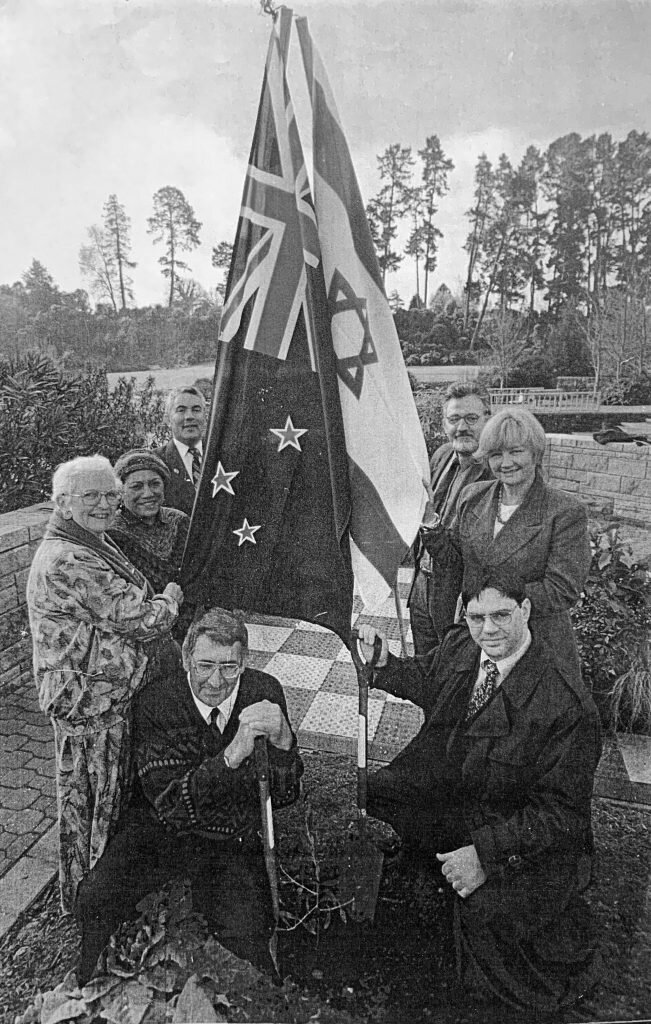The Māori Queen’s support for Israel
LH, back to front: Piripi Munro, Secretary to the Maori Queen; Maori Queen Te Arikinui Dame Te Atarangikaahu; Mrs. Margaret Voyle, President New Zealand Friends of Israel Society; Neil Collyer, Secretary of the New Zealand Friends of Israel Society. RH, back to front: Professor Dov Bing, Head of Department of Political Science and Public Policy, University of Waikato; Dame Margaret Evans, Mayor of Hamilton; Mr.Raanan, First Secretary, Embassy of Israel in Wellington.
“Ten measures of beauty were bestowed upon the world; nine were taken by Jerusalem, and one by the rest of the world.”1
This quote from the Babylonian Talmud of late antiquity, conveys the magic and mystery of the place that has captured countless imaginations over the centuries.
On the occasion of the 3000 year celebration of Jerusalem, 4 August 1996, Emeritus Professor Dov Bing was invited by the Māori Queen Te Arikinui Dame Te Atairangikaahu to speak at Turangawaewae Marae about the political, religious and historical meaning of this Holy City. Prof. Bing had met Dame Te Atairangikaahu on several occasions, having accompanied incoming Israeli ambassadors on visits to Turangawaewae Marae to present credentials. The Māori Queen in turn often celebrated Israel’s Independence Day, travelling to Wellington with her husband to attend official events.
Te Arikinui Dame Te Atairangikaahu’s love for Israel was not unique. Indeed Māori have long had a fascination with the Holy Land. Scattered around the motu are marae and small towns named Hiruharama (transliteration for Jerusalem) – from Hiruharama Hou (Te Tii) marae in the Bay of Islands to Hiruhārama marae (Patiarero) along the Whanganui River near the village of Jerusalem and Hiruhārama marae in the Gisborne district near the village of Hiruhārama.
The Māori prophetic movements of the nineteenth century, such as Pai Marire and Ringatū, drew great inspiration from the plight of the Old Testament Israelites. Te Ua Haumene, leader of Pai Marire saw himself as a new Abraham or Moses and his followers identified themselves as the Chosen People of God, with New Zealand being the new Canaan. Ringatū leader Te Kooti also fully identified the Māori people with the Children of Israel, and the plight of his people with that of the Hebrews.2
The symbolism of biblical narratives and associated motifs has been a source of strength not only to Māori, but to many people, in diverse places and times. Sadly, Jerusalem, the focal point of that strength and inspiration, has now become a political football, kicked around by those who seek to distance the city from its essential Jewish character and history. UNESCO has sought to deny Jewish indigeneity and the degree to which Jewish identity is inextricably linked to Jerusalem. Although this relationship predates the emergence of Islam by centuries, UNESCO resolutions have omitted the name “Temple Mount” for the holiest site in Judaism and only use the Muslim term, “Haram al-Sharif”, creating the absurd situation whereby the “…archaeological digs on and around the site of the Temple Mount, which have unearthed copious evidence of a Jewish connection to the site, may now be designated as destruction of the Muslim site.”
A recent image of the olive trees in the Hamilton Gardens
At the 3,000 year Jerusalem celebration that took place in Hamilton in 1996, Dame Te Atairangikaahu, Prof. Bing, Hamilton Mayor Dame Margaret Evans and others planted three olive trees as a symbol of the friendship between Hamilton, Tainui and Israel. Indeed Bing’s long association with Tainui iwi developed over the 46 years spent at the University of Waikato, where he championed Te Timatanga Hou (TTH), a programme equipping those who had been unsuccessful at secondary school to pursue a university education. The TTH programme has produced many high achieving Waikato-Tainui leaders, such as Rukumoana Scaffhausen and Rahui Papa. Bing also gained a lifetime membership award from the Teachers Education Union, for his leading role in establishing equity-oriented programmes at the university – including Māori Studies, Women’s Studies, Labour Studies, and the School of Law.
Prof. Bing’s paper, anchored with reference to classical texts, is a poignant reminder of the special connection of Jews to their ancient city and the importance of historical method in the battle against contemporary assaults on history.
Read the full text here
This was first published on the Israel Institute of NZ


